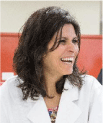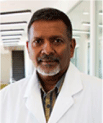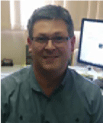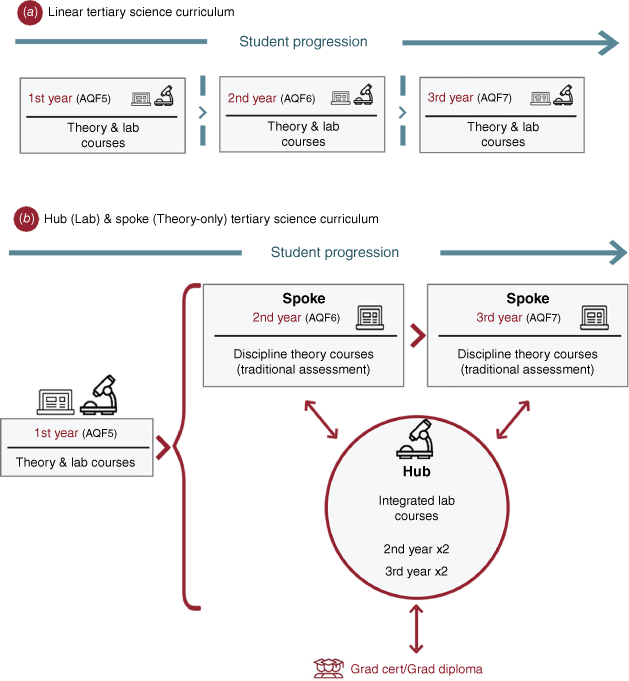A new hub-and-spoke biology curriculum designed around interdisciplinary laboratory practical sessions to enhance student employability
Gal Winter A * , Natkunam Ketheesan A and Nicholas M. Andronicos AA School of Science and Technology, The University of New England, Armidale, NSW 2351, Australia.

Gal Winter is a Senior Lecturer and Discipline lead in Biomedical Science at the University of New England. Her research is focused on understanding the microbiome of humans and plants and its contribution to health. She is particularly interested in the gut–brain axis and the connections between microbiome, food and mood. Gal is a passionate educator. In 2021, she has founded a community outreach initiative called ‘Gal’s Kitchen Culture’, an endeavour aimed at providing community hands-on education on cooking and healthy eating. After obtaining her BSc and MSc in Food Science and Biochemistry at the Hebrew University of Jerusalem, Gal moved from Israel to Australia to complete a PhD at the Australian Wine Research Institute, followed by a Postdoctoral Fellowship at The University of Queensland. |

Natkunam Ketheesan is a Professor in Biomedical Science (Infection & Immunity) at the University of New England, Australia. After obtaining his undergraduate education at the Vinnitsa State Medical University (Ukraine), he went on to complete his MSc in Clinical Immunology and PhD at the University of Leeds (UK). After holding combined teaching and research academic positions at the University of Leeds, The University of Western Australia, The University of Queensland and at James Cook University, he joined UNE in 2018. Dr Ketheesan’s research focus is on investigating the immune interactions between selected bacterial pathogens and the human host. As a passionate educator, he contributes to the development of innovative modes of curriculum delivery both in Australia and overseas. |

Nicholas Andronicos is an Associate Professor at the University of New England, Australia. He graduated with a Doctorate in Biological Sciences from the University of Wollongong (Australia). Nick did his first post doc at the Scripps Research Institute (California, USA) and was a research scientist at CSIRO, Australia. He currently teaches molecular genetics, biochemistry and immunology in biomedical sciences and medicine. Nick is a molecular immunologist who conducts biotechnological research as well as the development of veterinary vaccines. Finally, Nick leads an online education development team to enhance University of New England leadership in the online educational space and is currently leading the curriculum redesign hub-and-spoke lab skills initiatives. |
Microbiology Australia 44(3) 131-135 https://doi.org/10.1071/MA23039
Submitted: 3 April 2023 Accepted: 29 May 2023 Published: 23 June 2023
© 2023 The Author(s) (or their employer(s)). Published by CSIRO Publishing on behalf of the ASM. This is an open access article distributed under the Creative Commons Attribution-NonCommercial-NoDerivatives 4.0 International License (CC BY-NC-ND)
Abstract
A new hub-and-spoke (H&S) model for restructuring the traditional biological science curriculum is presented here. The H&S model emphasises the integration of sub-disciplines of biology and the integration of biology with other scientific disciplines. In this model, traditional undergraduate courses that include both theory and a stand-alone laboratory component are replaced with discovery-based research courses that act as the hub, servicing discipline-specific theory-only courses, which act as the spoke. The hub course includes an immersive laboratory experience, aimed to integrate all the spoke components that the hub unit serves. The H&S model also offers an opportunity to develop a new framework that will support active pedagogies such as inquiry-based and open-ended problem-based learning, where students work in groups to solve challenging problems and build their capacity to design and implement approaches to undertake their own investigation, thus enhancing students critical thinking as well as generic skills. Overall, this model offers higher interdisciplinary biological laboratory skills, and an integrative understanding of scientific projects thus enhancing the graduate’s employability. This curriculum model may be easily adapted for other branches of science, given the interdisciplinary nature of all sciences and the R&D innovation sector.
Keywords: biological science, biomedical, curriculum, laboratory skills, multidisciplinary education, practical skills.
Introduction
Two hundred years ago, Louis Pasteur famously declared that, ‘Without laboratories, scientists are soldiers without arms’, underpinning the laboratory’s key role in scientific innovation. Modern biomedical science advances have become ever more reliant on discoveries that are undertaken following laboratory experimentation. Therefore, it is imperative that we constantly revisit the science curricula to align the laboratory training of undergraduates with modern research requirements, learning outcomes and graduate attributes. A closer examination of the current undergraduate science curricula, reveals that laboratory components and their intergradation into subject material lag behind industry requirements and require modernisation.1–4 In the past, science was often divided into distinct disciplines, with researchers working within their specific areas of expertise. However, as biomedical research has evolved over the last two decades, it has become clear that solving many of the complex problems plaguing society will require a more integrated and multidisciplinary approach. For example, developing new vaccine requires the input from a range of professions not limited to biochemists, immunologists, microbiologists and clinicians.
Therefore, a fit-for-purpose, tertiary biological science education curriculum must align with current practices that emphasise interdisciplinary collaborations to solve intractable societal problems.5,6 This will involve a shift from predominantly educating students using a disciplinary-focused curriculum towards a more interdisciplinary pedagogy,7 with an emphasis on replacing standard undergraduate laboratory courses with discovery-based experimental research courses.6
This new biology pedagogy involves firstly, the integration of the sub-disciplines of biology and secondly, the integration of biology with other scientific disciplines. This paper outlines a plan to restructure the traditional biological science curriculum into a hub-and-spoke (H&S) model, designed to enhance teaching undergraduate student’s interdisciplinary biological laboratory skills (the hubs) while providing deeper learning of theoretical discipline-specific knowledge in the spoke courses (Fig. 1).
Comparison of a traditional and hub-and-spoke (H&S) curricula. (a) The traditional linear science curriculum has the laboratory sessions embedded within each of the courses, which has limited student exposure to the integration of experimental science opportunities in their degrees. (b) The proposed H&S curriculum in which the student laboratory sessions have been removed from each of the second- and third-year theory-only courses that are serviced by a specific hub lab skill course. This H&S science curriculum is expected to provide undergraduate students with multi-disciplinary experimental science learnings designed to simulate industry laboratory workflows, which when coupled with authentic assessment, may provide enhanced vocational training for science graduates compared to a traditional science curriculum.

H&S biology curriculum is designed to provide deeper lab and concept learnings for students
A molecular biology hub lab skills course servicing several biochemistry, genetics and microbiology, discipline-specific courses will be used here as an example of a full-time study semester or trimester load in the redesigned H&S curriculum model. However, for students studying part time, the H&S science curriculum model can be equally effective, since the full semester and trimester hub lab skills course contains all of the learning material required for the successful completion of the lab course, independent of the theory-only courses that deepen discipline-specific knowledge. The predominant science curriculum model used in universities for teaching these subjects is a traditional curriculum (Fig. 1a), which include dedicated disciplines, with stand-alone practical laboratory sessions for each discipline with minimal multidisciplinary integration. However, when students are taught using a traditional, silo linear curriculum they are less likely to understand the interdisciplinary nature of biological science in the contemporary innovation sector6 and speak a common scientific language.8 The H&S biology curriculum model may overcome these limitations by allowing students, enrolled in the theory-only spoke courses to deepen their discipline-specific concept knowledge. When several of these spoke courses are serviced by a single, interdisciplinary hub lab skills course with an industry-relevant, problem-based, authentic assessment pedagogy the student has the opportunity to apply their learnings from different theoretical subjects (spokes) (Fig. 1b). Therefore, the capacity to integrate knowledge and modes of thinking in different disciplines to produce a cognitive advancement, using biochemistry, genetics and microbiological knowledge are captured by the molecular biology lab skills hub course in the biochemistry strand.
Immersive laboratory experience
Essential to the success of the integrative hub unit is an immersive laboratory component, aimed to simulate real-world scientific projects that integrate all the spoke components that the hub unit services. In the molecular biology exemplar, an experimental component may include metabolic engineering of a microbial strain for an industrial process, followed by extraction and biochemical characterisation of one of the enzymes of the engineered pathway and the microbial characterisation of the engineered strain. The inclusion of this block experience rather than a collection of sessions is imperative for students’ sense of real-world scientific research in a commercial or academic workplace. This immersive laboratory component will be placed in the middle of the semester or trimester, allowing sufficient time for students to design the project before implementing it in the lab and sufficient time for follow-up analysis and writing of the project. Students will work in teams with different team members taking leadership on different aspects of the project. Therefore, spiral learning opportunities from the hub lab skills courses in the H&S curriculum could collectively be used as pre-requisites for a capstone student research course to further prepare students for success in graduate research degrees or for entry into the workforce.
Learning objectives, skills and assessments
In designing a model that aims to increase student entry into the innovation sector, we must first define employability and the main factors that influence it. This has been discussed in the literature at length (e.g. Quinlan and Renninger 2022,9 Boden and Nedeva 2010,10 Sarkar et al. 202011 and references within), with a general agreement that realistically, it is unreasonable to expect that new graduates will have all the knowledge, skills and abilities required of them in the workplace. However, generic skills such as an awareness of their strengths and limitations, as well as graduate attributes of an attitude to continue situational learning, communication and team-working are important facets to conceptualise employability.12,13 Indeed, studies of science graduates in the UK demonstrated that graduates valued generic skills higher than subject knowledge.11 A recent study examined the perspectives of science academics at an Australian and British universities regarding the promotion of generic employability skills in the subjects they teach.11 The study demonstrates that, although the traditional curriculum emphasises analytical skills, generic employability skills such as leadership, flexibility or adaptability, commercial awareness, and information and communication technologies (ICT) skills are often neglected.11
The H&S model offers an opportunity to develop a new framework that will support active pedagogies such as inquiry-based and open-ended problem-based learning, where students work in groups to solve challenging problems and build their capacity to design and implement approaches to undertake their own investigation. Using real-world scenarios, students will acquire the knowledge, skills and competencies that are most valued by employers.
One of the key strengths of such a H&S biological sciences curriculum model is that both traditional and authentic assessment tasks can be utilised to monitor student knowledge, analytical skills and generic skills. For example, students studying in the theory-only, discipline-specific spoke courses can be examined using the more traditional assessment tasks such as invigilated exams, oral presentations and essays. By contrast, the assessment tasks used in the interdisciplinary lab skills courses can be more representative of the types of activities undertaken by researchers in the R&D innovation sector and highlight skills like team-work and leadership as well as analytical and critical thinking skills. Using the molecular biology lab skills course as an exemplar, authentic assessments may include tasks such as project design, in silico plasmid design, microbial strain engineering, definition of a research proposal, as well as the preparation of statutory regulation applications (e.g. ethics applications and student attendance at an ethics committee meeting), writing mock funding applications using pilot data generated in the wet lab sessions of the lab skill courses and quantitative data analysis skills for scientific writing. Hence, redesigning a traditional biological sciences curriculum from a traditional to an H&S model provides an opportunity to expose students to a more diverse range of traditional and authentic assessment opportunities to hone their skills for success in the innovation R&D sector.
Logistical considerations associated with implementing a hub-and-spoke science curriculum
When designing the hub lab skill courses, it is important to acknowledge that there will be a significant financial, academic workload and time costs associated with the design and establishment of these courses. Therefore, academic leaders need to account for these costs and provide enough time, resources and teaching relief to academics for course development and curriculum redesign. Secondly, the scalability of student labs needs to be considered. For example, the experiments that worked in student lab sessions that were embedded within discipline-specific courses that had fewer enrolments may not necessarily work when these same experiments are scaled-up into hub lab skill courses with more enrolments because they simultaneously service more students from several spoke theory-only courses. Moreover, as part of establishing the hub lab skills course, the university may have to commit funds upfront to purchase the necessary laboratory equipment to run these larger scale hub lab skill courses. However, if the curriculum and the hub lab skill courses are designed sustainably the initial setup costs should be offset by the reduced running and academic workload costs associated with running these courses. Collaboration between academics and learning designers to develop high quality learning materials that will be required to support effective student learning, which is especially important for part time student success or for students who study the hub lab courses out of sequence. It is anticipated that the hub lab skill courses will enable the removal of laboratory experiments from individual discipline-specific courses and therefore provide teaching efficiencies that are expected to have positive effects on academic, technical officer and student workloads, while providing enhanced educational outcomes for undergraduates.
Is experiential learning limited to ‘hub’ units?
Proponents of this model may argue that students might be disadvantaged by the disconnect between the theory and its laboratory application.14 In addressing this argument, we distinguish practical application and laboratory-based application, with the understanding that practical application can be provided outside the laboratory settings and be used to reinforce theory content.15 The recent COVID-19 pandemic accelerated the splurge of creativity and ingenuity in the development of online and remote teaching resources, created in a very short timeframe. There are ample examples in the science education literature demonstrating the benefits of online or remote resources and the merits of using these resources long after the social restrictions were lifted. One specific example that has been developed at the University of New England includes gamified 2-D online lab simulations,16 produced to enhance deep learning of theory concepts by science students, resulting in better learning outcomes.17,18 Another is the development and the implementation of a Microbiology at Home (M@H) curriculum, aimed to provide laboratory-like experience in microbiology in a home environment using an M@H consumables home kit, interactive simulation, online resources, and lecturer guidance (G. Winter and N. Ketheesan, unpubl. data). We believe that there is an overwhelming case for the rational integration of interdisciplinary laboratory practicals into a H&S format for subjects to extend the learning opportunities and outcomes of undergraduate biological science students. Moreover, this curriculum model may be easily adapted for other branches of science, given the interdisciplinary nature of all sciences and the R&D innovation sector.
Conclusions
The current tertiary biological science curriculum needs to be modernised to align with the contemporary interdisciplinary approach to scientific experimental research as well as current technologies and demand for flexibility in the tertiary education sector. This H&S model has the capacity to provide deeper learning of theoretical discipline-specific knowledge in spoke courses, while enhancing interdisciplinary biological laboratory skills in hub lab skills courses. Overall, the H&S curriculum approach is an effective solution to provide students with critical thinking skills, generic skills and a common scientific platform for future interdisciplinary research. However, the design and initial establishment costs of implementing a H&S curriculum need to be carefully considered by the academic leadership.
References
1 Sella A (2017) Rethinking practical classes. Nat Rev Chem 1, 0090.
| Crossref | Google Scholar |
2 Gunn JS et al. (2018) Biomedical science undergraduate major: a new pathway to advance research and the health professions. Teach Learn Med 30, 184-192.
| Crossref | Google Scholar |
3 Dietert RR (2014) Integrating contemplative tools into biomedical science education and research training programs. J Biomed Educ 2014, 239348.
| Crossref | Google Scholar |
4 Hart JL (2019) Interdisciplinary project-based learning as a means of developing employability skills in undergraduate science degree programs. J Teach Learn Grad Employab 10, 50-66.
| Crossref | Google Scholar |
5 Knowlton JL et al. (2014) Teaching interdisciplinary sustainability science teamwork skills to graduate students using in-person and web-based interactions. Sustainability 6, 9428-9440.
| Crossref | Google Scholar |
6 Olson S, Riordan DG (2012) Engage to excel: producing one million additional college graduates with degrees in science, technology, engineering, and mathematics. In: A Report by the President’s Council of Advisors on Science and Technology. 7 February 2012. Executive Office of the President. https://obamawhitehouse.archives.gov/sites/default/files/microsites/ostp/fact_sheet_final.pdf
7 Tripp B, Shortlidge EE (2019) A framework to guide undergraduate education in interdisciplinary science. CBE Life Sci Educ 18, es3.
| Crossref | Google Scholar |
8 Bracken LJ, Oughton EA (2006) ‘What do you mean?’ The importance of language in developing interdisciplinary research. Trans Inst Br Geogr 31, 371-382.
| Crossref | Google Scholar |
9 Quinlan KM, Renninger KA (2022) Rethinking employability: how students build on interest in a subject to plan a career. High Educ 84, 863-883.
| Crossref | Google Scholar |
10 Boden R, Nedeva M (2010) Employing discourse: universities and graduate ‘employability’. J Educ Policy 25, 37-54.
| Crossref | Google Scholar |
11 Sarkar M et al. (2020) Academics’ perspectives of the teaching and development of generic employability skills in science curricula. High Educ Res Dev 39, 346-361.
| Crossref | Google Scholar |
13 Gilbert R et al. (2004) The generic skills debate in research higher degrees. High Educ Res Dev 23, 375-388.
| Crossref | Google Scholar |
14 Hofstein A, Lunetta VN (2004) The laboratory in science education: foundations for the twenty-first century. Sci Educ 88, 28-54.
| Crossref | Google Scholar |
15 Serrano-Perez JJ et al. (2023) Traditional vs. virtual laboratories in health sciences education. J Biol Educ 57, 36-50.
| Crossref | Google Scholar |
16 Burns A, et al. (2021) Student response to a multi-topic kitchen practical experience in undergraduate core biology. In: ACSME 2021 Proceedings: Sustainable Transformation of Science Education, 29 September–1 October 2021, held virtually. The University of Sydney. https://openjournals.library.sydney.edu.au/IISME/article/view/15470
17 Andronicos NM, et al. (2021) Gamified lessons support molecular genetics education of first year biology students during COVID-19 lockdown. In: ASCILITE 2021. Conference Proceedings: Back to the Future (Gregory S, Warburton S, Schier M, eds), 28 November–1 December 2020, held virtually. pp. 246–256. University of New England, Armidale, NSW, Australia. https://2021conference.ascilite.org/wp-content/uploads/2021/11/ASCILITE-2021-Proceedings-Andronicos-Barnett-Roberts-Chong-Labeur-Henderson-Burns.pdf
18 Huang R et al. (2020) The impact of gamification in educational settings on student learning outcomes: a meta-analysis. Educ Technol Res Dev 68, 1875-1901.
| Crossref | Google Scholar |


